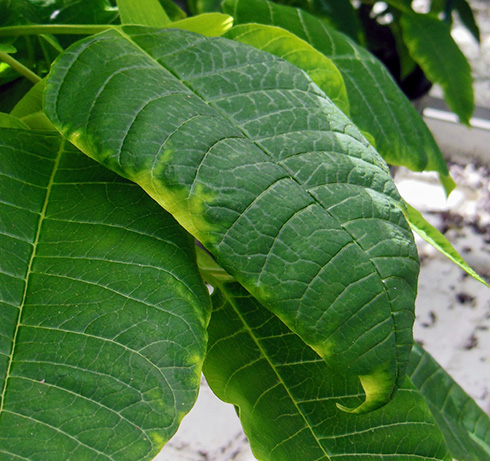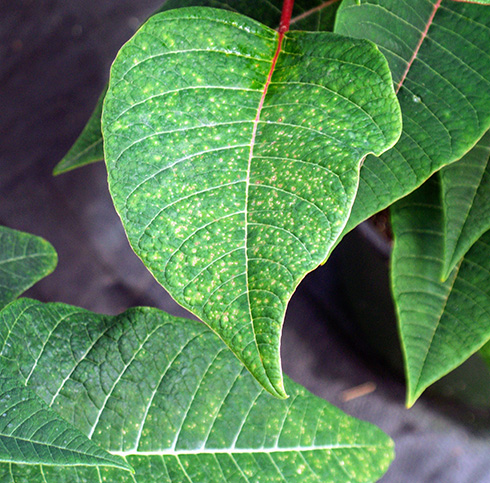Molybdenum deficiency in poinsettia
Molybdenum (Mo) deficient poinsettias exhibit halo-like marginal leaf chlorosis (yellowing) on recently matured leaves, leaf distortion or rolling and leaf edge burn.

Molybdenum (Mo) is an essential micronutrient and taken up by plants as molybdate (MoO42–). However, when Mo is limited, plants can become deficient. During poinsettia (Euphoria pulcherrima) production, Mo deficiency can occur.
The most common symptomology observed is a thin, marginal chlorotic (yellowing) halo-like band that occurs on recently matured leaves (middle of plant) ranging from the leaf tip to base (Photo 1). Leaf distortion, rolling (Photo 2), and leaf edge burn or necrosis (death) may also be observed.
To prevent Mo deficiency, consider providing supplemental applications of Mo. On a continuous basis, apply 0.1 ppm Mo provided by ammonium or sodium molybdate. These two sources can be applied as a corrective procedure at a rate of 2 ounces per 100 gallons of water. Once mixed, the solution can be applied as a substrate drench or foliar spray. If applied as a foliar spray, be cautious of phytotoxicity (Photo 3), especially if chelated Mo is used. Molybdenum is more readily available at higher pH levels, so avoid letting the substrate pH fall below 5.5 to help maximize uptake by the plant.

In addition, Michigan State University Extension recommends monitoring substrate pH and soluble salt—referred to as electrical conductivity (EC)—by easily performing in-house 1:2 Dilution, Saturated Media Extraction (SME) or PourThru procedures. Each method will determine substrate pH similarly, however EC values vary with each method. For more information, refer to “Fert, Dirt, & Squirt: Monitoring pH & EC of Greenhouse Crops Book” from MSU Extension.

Corrective procedures for low substrate pH should begin within the range of 5.4 to 5.5. Be sure your pH and EC meter is working correctly and calibrated regularly. For a “how to video,” watch “How to Calibrate a pH and EC Meter” from MSU Extension. Also, consider having plant tissue and substrate analyzed for nutrient content by submitting samples to analytical labs or the MSU Soil and Plant Nutrient Laboratory.
For low or high pH or EC corrective procedures, refer to “Corrective procedures for high and low substrate pH and electrical conductivity” from MSU Extension.
For more nutritional monitoring of greenhouse crops, read “e-GRO launches Nutritional Monitoring of Floriculture Crops website” and “In-house nutritional monitoring app provides optimal substrate pH and EC levels” from MSU Extension.
The American Floral Endowment is gratefully acknowledge for funding to create fertdirtandsquirt.com and establish all available materials.



 Print
Print Email
Email

